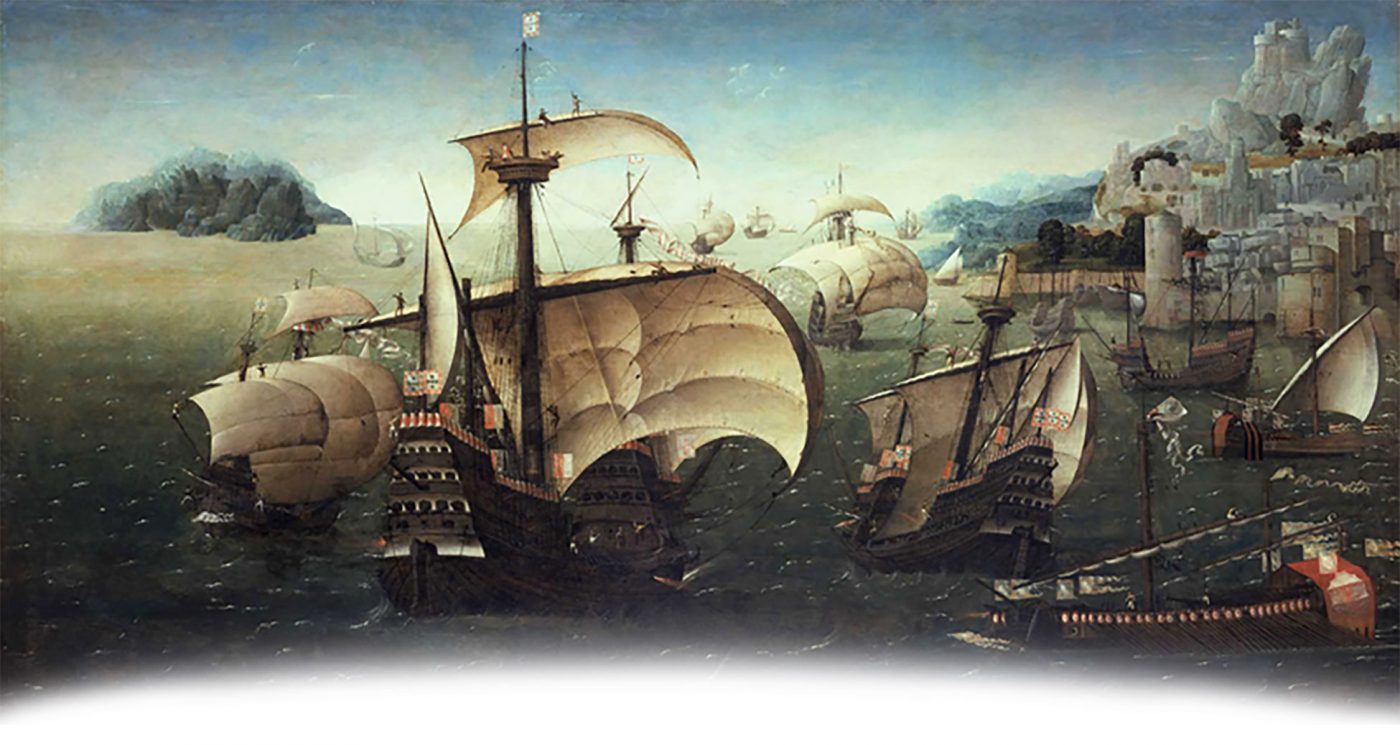
The economic prosperity of the Burgundian–Habsburg Netherlands from the fourteenth to the sixteenth centuries was based to a large extent on the trade in textiles, primarily wool, from high-quality heavy fabrics to lighter weight cloths, which were more popular in warmer southern European countries, but also linens and mixed fabrics. The textile centres of northern France, Flanders, and Brabant, such as St Omer and Ypres, later Bruges and Mechelen, Brussels and Antwerp, were important centres for the associated industries of dyeing and finishing. As well as being one of the principal dyeing centres, Bruges was the focus of international trade until late in the fifteenth century, the place where merchants from all over Europe apart from England had houses or agents and could meet one another, and goods could be bought and sold. Antwerp and nearby Bergen-op-Zoom had four fairs a year (two each, Antwerp around Whitsun and the feast of St. Bavo on 1 October, Bergen-op-Zoom around Easter and All Saints Day), attended by merchants from England and southern Germany as well as the merchants from Bruges. It was more for political reasons than for the fact that the Zwin channel connecting Bruges to its port at Sluis by way of Damme silted up that Antwerp took over as the centre of northern European trade until the last quarter of the sixteenth century [Figure 1].[1]
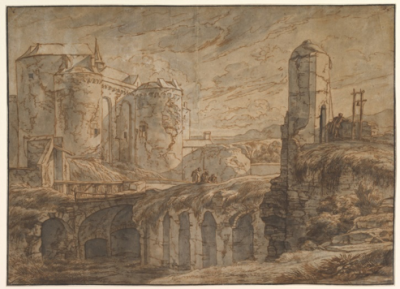
It could be said, in fact, that the machinery of trade throughout medieval Europe was powered by exchanges of textiles, precious metals, and spices, with Bruges being its northern hub. In the fourteenth and fifteenth centuries, long-distance trade between Asia and eastern Mediterranean cities like Constantinople, Beirut, and Alexandria was largely conducted by merchants from the Levant and Asia. Italian merchant shipping, primarily from Genoa and Venice, took over from the eastern Mediterranean and on to the rest of Europe. This pattern changed at the end of the fifteenth century and in the early years of the sixteenth with the voyages to the Caribbean islands and Central and South America by Christopher Columbus, sailing west across the Atlantic Ocean from Spain in his quest for gold and a new route to the riches of Asia. The Americas did indeed provide gold and silver, as well as other useful natural products and, later, a link to the Spice Islands. At about the same time, in the late 1490s and following on from visits down the west coast of Africa by Portuguese explorers earlier in the century, Vasco da Gama sailed from Lisbon in Portugal round the Cape of Good Hope to the coast of southern India, landing near Calicut (Kozhikode), and thus finding an alternative route to the riches of the South-East Asian islands and the pepper, nutmeg, exotic silk textiles, and other commodities desired in Europe [Figure 2].[2]
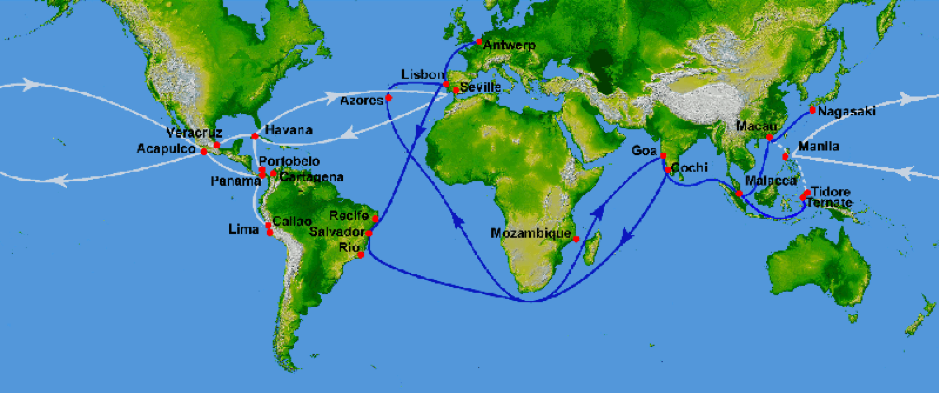
Dyeing Materials
Until the sixteenth century the substances used in dyeing — both the dyestuffs and the minerals used as mordants — formed a relatively small part of this long-distance trade; to a large extent, Europe itself was the source of what was needed. Plant dyes such as woad, madder, and weld, giving blue, red, and yellow respectively, were all grown widely, although certain areas — Zeeland in the Netherlands for madder, Picardy and Languedoc in France for woad — were particularly important. The trees that supplied bark or wood for dyeing browns, greys, and blacks, including young fustic, oak, and alder, all grew in Europe. The expensive scale insect dye, kermes, used to dye the highest quality wools and silk scarlet red, was harvested in the south of France and Spain, although it could also be found across the Mediterranean region. The even more expensive Polish crimson-dyeing scale insect came, as its name suggests, from Poland, but it could also be imported from much further east, along with the Armenian crimson-dyeing scale insect and possibly other related insects, now little known. Oak galls, used for ink and also for dyeing black, came from southern Europe, but were also imported from eastern Mediterranean countries. Only sappanwood and lac, used for reds, and indigo extracted from the indigo plant came from as far as South-East Asia. This indigo, as opposed to woad indigo, was not widely used in dyeing in Europe until later in the sixteenth century, partly due to the opposition of the European woad industry; even then, initially it was added to the woad vat, rather than being used alone. Of the minerals used as mordants, pyrite (iron(II) disulfide), found in mountainous regions across Europe, had been used for centuries to manufacture copperas (iron(II) sulfate) by natural weathering; copperas was also used in making ink. The most important mordant was potash alum (aluminum potassium sulfate), commonly purified from its mineral form alunite by roasting, weathering and dissolving out the pure potash alum. This was imported from Phocaea (Foça) on the west coast of Anatolia until a large and very productive deposit of alunite was discovered in Tolfa, north of Rome, in 1462, and also a site at Mazarrón, near Cartagena, Spain.[3]
With the discovery of the Americas and the Caribbean islands, a new range of dyes became available, the most important of which was probably cochineal. This scale insect gave a dye that was recognised as being the same as that given by the Old World insects already used, but it was a very much richer source. Brazilwood, too, was recognised as giving the same dye as sappanwood, with its known disadvantages of impermanence. A wood that dyed yellows and tawny colours was so similar to the European young fustic that it received a similar name: old fustic in English, palo fustete in Spanish. Sources of indigo were also identified. The most interesting new dye source was logwood, which gave blues and black; initially popular, its dye was found to be impermanent and it had a checkered history in the late sixteenth and seventeenth centuries.[4]
The dyes used to give black came from within this group of materials, and only the oak galls were usually imported from the Mediterranean region. All contain tannins that can dye black when used with a source of iron as a mordant. This need not be copperas: iron turnings and the swarf left from machining or grinding were also used. The tannins themselves were the source of acid that could bring this into solution; vinegar, verdigris and other ingredients could also be added. Unfortunately, the overall acidity of the dyeing itself, together with the later generation of acidic and/or brownish products by reactions of the iron, caused damage to the textile.[5]
In practice, all over Europe the use of this group of materials was forbidden on high-quality wools and only permitted on silks, linens and cheaper mixed fabrics, such as fustian. Even then, silks imported from Italy and further east into the Burgundian–Habsburg Netherlands included some very expensive fabrics, as can be seen in a list of fabrics purchased to provide suitably impressive clothing for the retinue of Charles the Bold, Duke of Burgundy, for a meeting held with the German Emperor, Frederick III, in 1473 to discuss the betrothal of his daughter Mary to the Emperor’s son, Maximilian [Figure 3]. The silk fabrics included (in descending order of cost) gold and silver cloths and – listed separately – brocades, velvets, damasks, and satins, of high quality and selected according to the status of the wearer. Other than the gold and silver threads used, a very high proportion of the silks were dyed crimson violet (cramoisy violet) or black (other colours included crimson, violet, and blue).[6] The silk used for such high status cloth would have been very carefully dyed. The guild of Genoese silk dyers (the Arte dei tintori di seta), who had a reputation for the production of high-quality black-dyed silk, approved a statute in 1486 that listed the ingredients permitted for dyeing silk black; these included oak galls, copperas, iron swarf, vinegar and, interestingly, madder, but not alder or oak bark.[7]
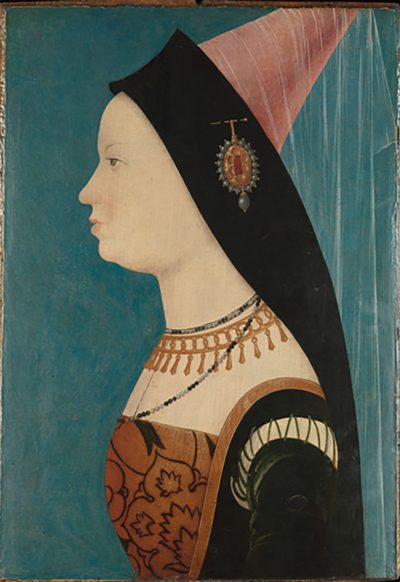
Dyers in Bruges or Mechelen or the other textile centres of Flanders or Brabant would have been more accustomed to dyeing materials other than silk, notably imported high-quality wool. For these expensive wools an alternative process was used, whereby the wool was dyed the deepest shade of blue in the woad vat, followed by application of an alum mordant and dyeing in a madder bath (or occasionally, and at even greater expense, with kermes). The brunette shade obtained — a deep, rich black, perhaps slightly bluish or reddish, depending on the conditions and colour of the madder dyeing — was the most expensive and permanent black available, expensive because it required two quite different dyeing processes, the vat dyeing of the woad indigo blue, followed by the mordant dyeing of the madder red, carried out by different dyers. As cheaper, lighter-weight, but still good quality wool fabrics grew in importance in the later fifteenth and sixteenth centuries and weaving moved out to rural centres in Flanders and Brabant, the prohibition of iron-tannate dyes on wool became increasingly untenable; eventually the use of dyes with an iron mordant was permitted, but only on a wool first dyed blue in the woad or indigo vat, thus reducing the need to use too much iron mordant.[8]
The Movement of Materials
Trade with Italy
Mediterranean trade, during the fourteenth and fifteenth centuries at least, was largely in the hands of Italian merchants. Cities of northern and central Italy, such as Florence, Genoa, and Venice, had developed sophisticated trading methods, with appropriate systems of accounting, banking, and insurance of the goods, during the thirteenth century. The port cities of Genoa, Venice, and Pisa, which controlled trade with the cities of the eastern Mediterranean and thus the European end of the spice trade from further east, already had small colonies of people living permanently in Constantinople and other cities. By the fourteenth century, large merchant companies from Venice, Genoa, Florence, and other cities had resident agents in cities abroad to make the sales or purchases according to the wishes of the head office of the organisation at home. The actual movement of goods might take place by road or by sea, employing carriers or ship owners as necessary [Figure 4]. Examples of these companies include the Bardi (also a banking company) and the Peruzzi of Florence, who had agents in Bruges, London, and other cities at the beginning of the fourteenth century.[9]
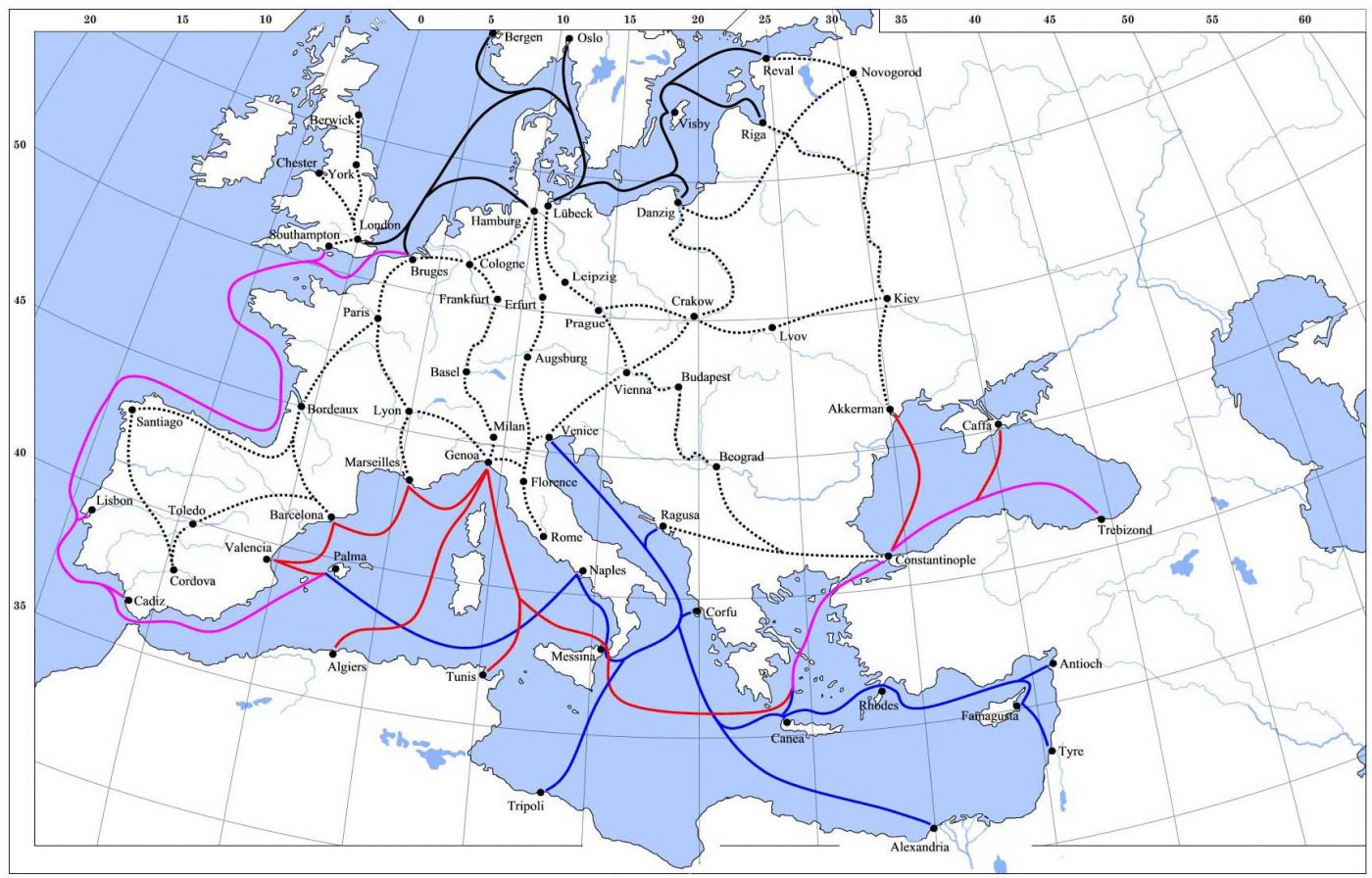
The Bardi representative in Antwerp in 1315 and then London from 1317 to 1321 was the Florentine Francesco Balducci Pegolotti, the author of a handbook for merchants, La pratica della mercatura, written around 1340. Pegolotti describes by what system of weight or volume goods are sold in the various cities where a Florentine company might trade, as well as the goods themselves; the currencies; the dates on which a local fair might be held and the tolls that might be paid. For Bruges, for example, he observed that goods actually arrived at Sluis (Schiuse) and then Damme (Damo) so that, depending on exactly where the goods were to be sold, one needed to be careful about where to pay the tolls.[10]
The group of companies run by Francesco di Marco Datini from Prato in Italy at the end of the fourteenth century and beginning of the fifteenth had trading houses in Florence, Pisa, Genoa, Avignon, Majorca, Barcelona, and Valencia and agents in many other cities, including Venice and Bruges. The activities of the Datini group are particularly well known because so much of the paperwork generated from 1363 to 1410, from letters to accounts and also bills of lading for ships and fabric samples, has survived and is now housed at the Archivio di Stato di Prato, Fondo Datini. Most of the surviving correspondence from Bruges agents was addressed to the companies in Barcelona, Majorca, and Valencia, not to Datini in Prato himself. In practice, most of the dealings Datini had directly with countries abroad were with France and Spain; only a small percentage were with the Low Countries. Goods arriving in Bruges came by way of Lisbon, having arrived there probably from Majorca.[11]
The ships used for trading goods traded by sea were quite substantial: Pegolotti wrote that goods travelled between Bruges and Sluis through Damme in small ships, having arrived in something larger, such as a galley or a cog. The sturdy, flat-bottomed cog carried about 200 tonnes while the largest Venetian galleys could carry about 270 tonnes [Figures 5, 6, 7]. The Genoese and, later, Portuguese carracks were much larger; those used by the Portuguese on journeys around the Cape of Good Hope to South-East Asia could carry about 900 tonnes of cargo.[12]
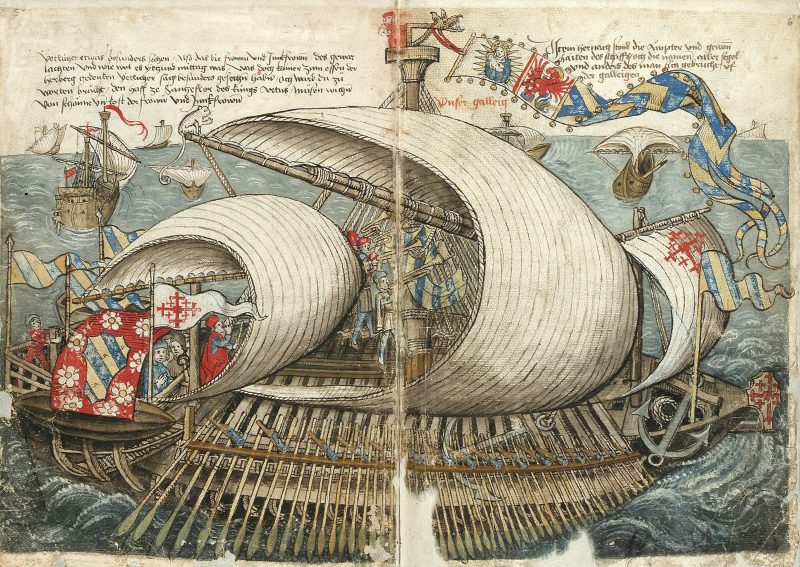
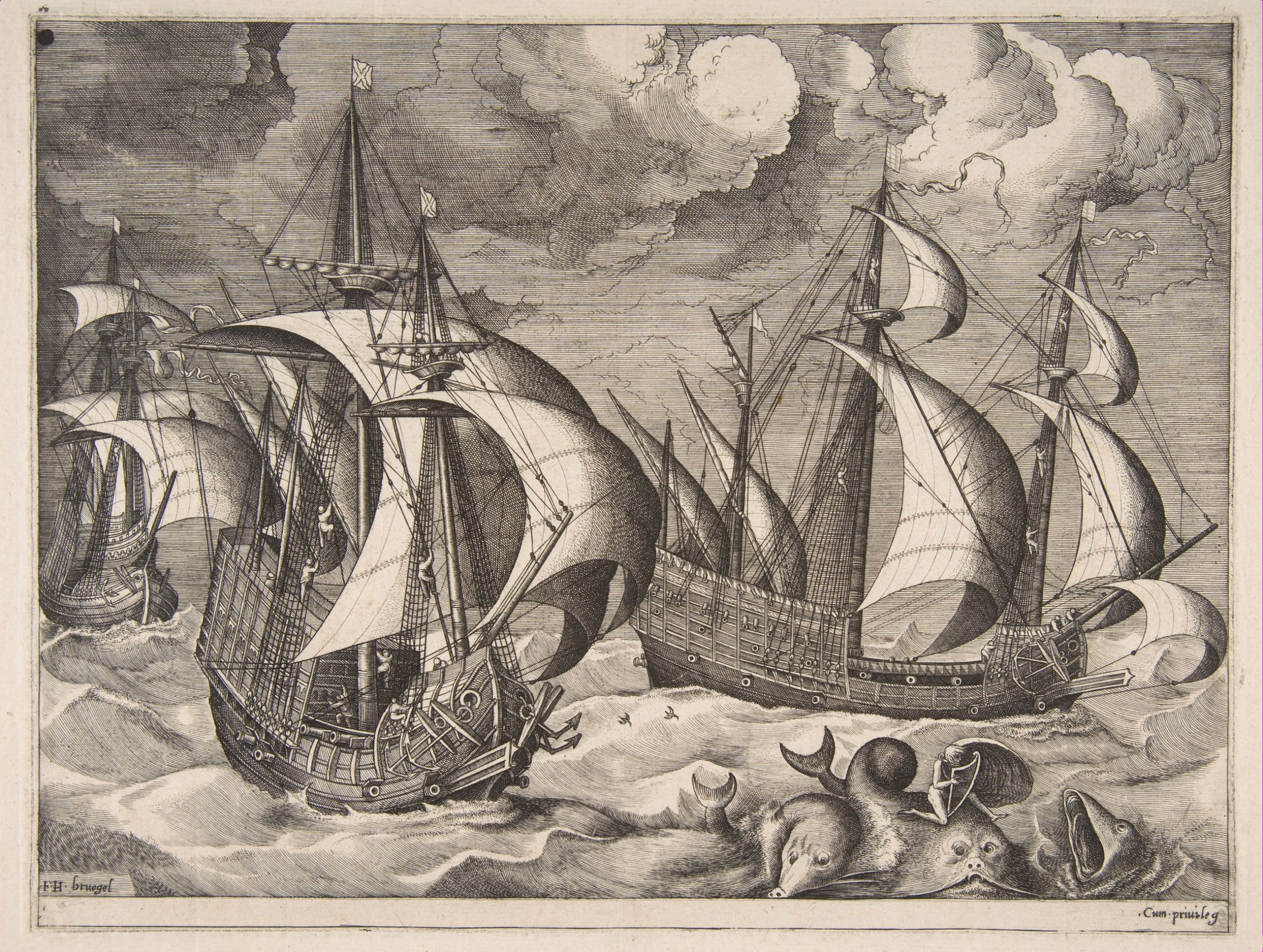
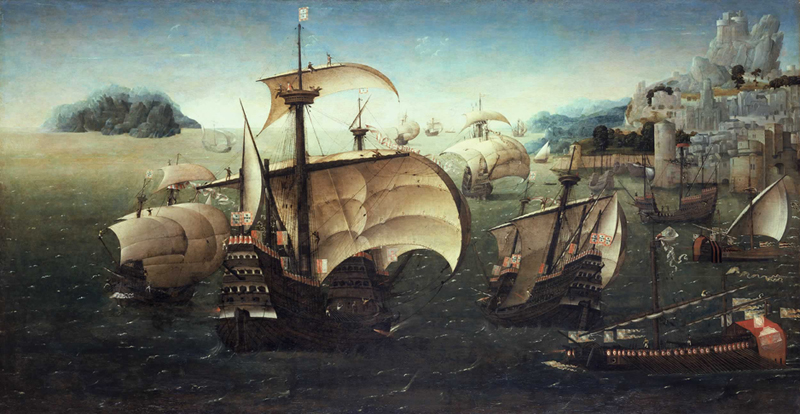
From 1315, the ‘Flanders galleys’ from Italy arrived in a convoy in Bruges or, later, Antwerp, once or twice a year fairly regularly (less so mid-century), calling in at Southampton or other ports on the way there to load bulky items like English wool and on the way back to unload Flemish cloth. Shipping based in Bruges or Antwerp itself made this long-distance journey infrequently in the fifteenth century; it seems also that merchants from these cities were rarely masters of international companies with branches in southern Europe and a need to organise long-distance sailing. In the 1480s, however, the Despars family of Bruges did exactly that, with bases in Bruges and Lisbon. Some seventy years later, Jan della Faille of Antwerp and his family developed a more substantial enterprise, trading overland with Venice (where Jan had begun his career), through Cologne, Nuremberg, and Augsburg, and by sea with Lisbon and Seville. The sea trade was expanded when Jan’s son Maarten took over the company in the 1580s, travelling to Palma, Genoa and Naples, as well as to Venice; the land route to Venice was also continued.[13]
Flanders and Brabant Shipping in the Fifteenth Century
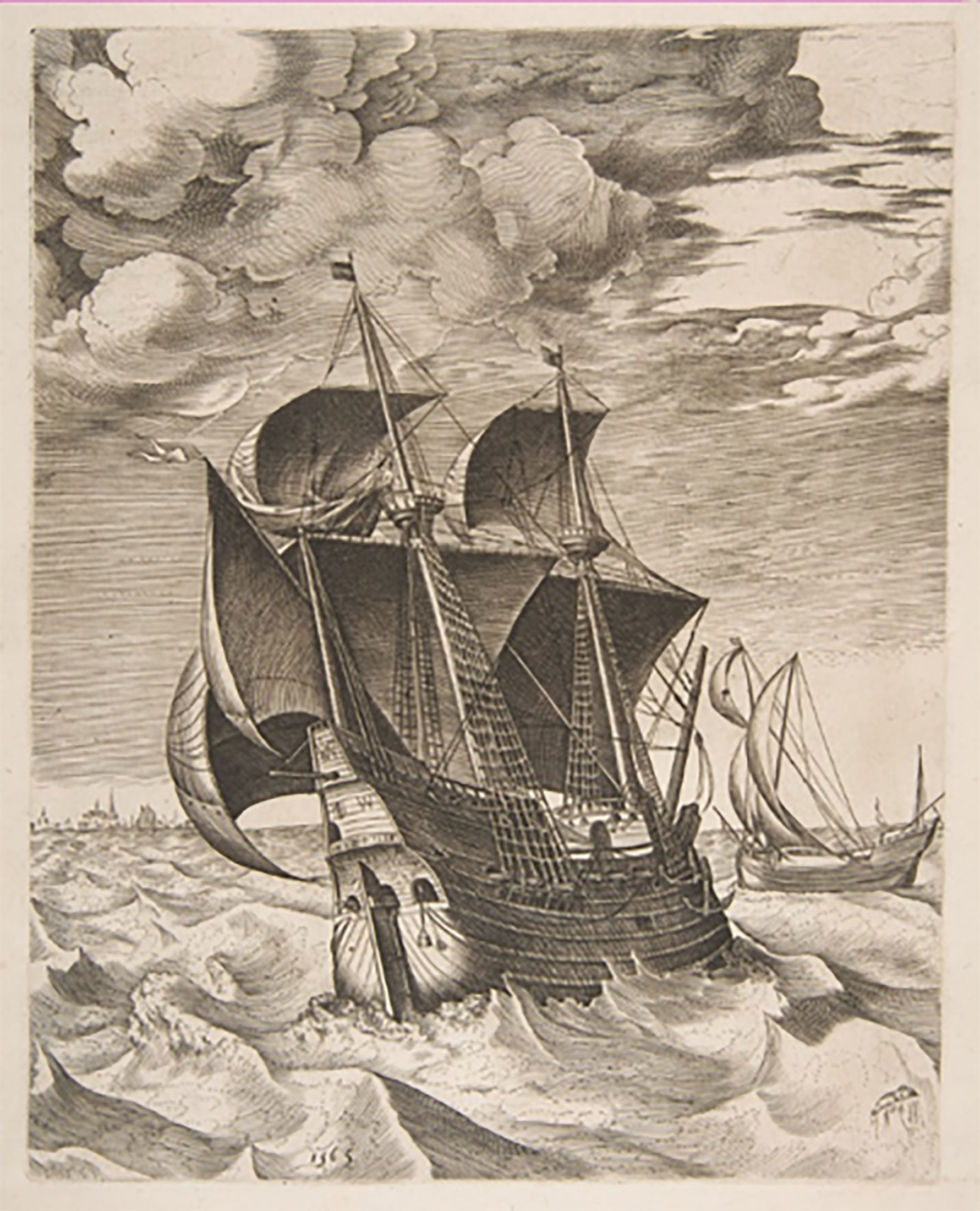
Ships from ports in Flanders, Brabant, and Zeeland typically sailed over shorter distances, across to English or Scottish ports, south to French ports on the Atlantic coast, and north to Friesland, the Baltic Sea, and Hanseatic ports [Figure 8]. Records of the English trade– in the form of accounts documenting duties payable on imported goods collected at the designated customs ports, or, from 1565, the port books– list the goods arriving in London, the English east coast ports, and Southampton, although the survival of these records is irregular and the amount of detail included varies. In the fifteenth and sixteenth centuries, much of this trade was with Antwerp as the English Merchant Adventurers had their base in the city until the late 1560s. As registers of ships and their captains were kept in Antwerp, it is sometimes possible to tie the two ends of the trade together.[14]
The large quantities of madder, woad, alum, copperas, and occasionally oak galls documented as arriving in England came through Antwerp, even if they did not actually originate there. The names of certain ship’s captains appear repeatedly: for example, Claus Bollaert, one of the most important fifteenth-century Antwerp captains, sailed to London and Southampton as well as the east coast ports of Great Yarmouth, Ipswich, and Woodbridge. In October 1411 he travelled to Great Yarmouth carrying woad for Robert Daxster. In December 1442, his ship carried six bales of madder for Johan Reynken, three for Willem Halle, and 200 pounds of copperas for Alan Corbett, while in August 1458, he carried two vats of copperas for Jacob Wight and thirty-six bales of madder of different grades for several different merchants.[15]
Captains and their ships were commonly hired by companies or individuals to carry merchandise or passengers, often on a regular basis; merchants might invest in the ships themselves, as several London mercers did. During the 1440s, Bollaert was employed by the London mercers quite regularly to carry their goods, although usually they used Zeeland or English ships, having had a long association with ships of Zeeland and Holland. Bollaert was also one of those who sailed to both Italy and Danzig.[16]
Records of French fifteenth- and sixteenth-century coastal trade include many for goods travelling north by way of coastal ports, including Bordeaux and La Rochelle, to ports serving Bruges or Antwerp, or further on to England. The commodities carried included large quantities of woad, essential for dyeing blue, and, as discussed above, as a ground for a black dye. To give a typical example, a bill of lading was issued at Bordeaux on 6 April 1497 stating that Jehan Defalzedo, servant of Martin Desalzar, living in Burgues (Burgos), Spain, was sending 112 bales of pastel (woad), eight bales in each tonneau, to the ship Le Hubert of Cerissé (Zierickzee), Zeeland, master Jehan Corneillisson, who was to take it to Zierickzee, from where it was to be sent to Jehan Devillaren, merchant, living in Bruges. The same quantity of woad was to be sent to Zierickzee under the same conditions on La Julienne, master Harman Ymansson. Payment conditions and what was to happen if the cargo was damaged are also given.[17]
Antwerp Trade
Apart from the duties payable when commodities entered or left ports, countries, or cities, tolls were also imposed for other reasons, such as the maintenance of roads or bridges. These various taxes could be quite substantial so that careful calculations were necessary before a merchant decided whether to send goods by road, river, or sea, assuming there was a choice and also bearing in mind the need to insure the merchandise. For Antwerp, other groups of records help to describe the movement of materials: these are the shipping registers and certificatieboeken, certificate books. The certificates exist from 1468, and 74 certificate books were compiled between 1488 and 1614, although the sequence is not complete. The system was by no means unique to Antwerp: similar systems existed in Bergen-op-Zoom, Bruges, Ghent, Cologne, and other cities. In the case of Antwerp, certificates were issued whereby a declaration was made, usually in front of a magistrate, on behalf of an applicant concerning a particular commercial or legal issue. Frequently these concerned the ownership of goods and confirmed the identity of the applicant; when and where the transaction took place; what kind of transaction it was; the goods; the means of transport and who was involved. By the sixteenth century Antwerp had an important position as a hub for road transport, and a large number of the certificates describing the movement of goods relate to this. By this time also, the number of foreign merchants and others living in Antwerp or having a business relationship with the city was very large indeed.[18]
Over the years the certificatieboeken documents provide evidence for the large quantities of woad coming from France; in fact, woad and wine made up two-thirds of the imports from France into mid-sixteenth century Antwerp. A great deal of madder and alum also passed through Antwerp, as well as all the other commodities; the city held the alum staple from 1491, thus all imported alum had to be offered for sale there first. Much of the road traffic was on its way to Cologne, Frankfurt am Main, Augsburg, or Nuremberg, then perhaps on to the south, carried by specialist German companies in large wagons, the Hessenwagen [Figure 9].[19]

A typical example of the Antwerp shipping traffic is a declaration dated 3 October 1505 stating that, during the fair of St. Bavo, Colyn Savalle, master of La Sint Nicolaus, had loaded goods belonging to Jaquet Martel, Jan Decherville, Willeme Surse, factor of Jan Pauveay, and Ernoul Grassart, all of Rouen, to be taken to Rouen. The goods belonging to Willeme Surse included three bales of gallnuts, four pipes and one tonneau of copperas, and two bales of madder, as well as a tonneau of white copperas (zinc sulfate), three little boxes of sugar candy, and various other things. Galls also travelled by road: on 15 October 1507, Anthonis van Genewe of Cologne declared that ten sacks of gallnuts, being taken to Cologne by the Cologne carrier Herman Sterck, belonged to him. Pieter Vuysken of Duren (Düren, near Cologne) declared on 9 October 1512 that he was the owner of a sack of vitriol and a sack of gallnuts, as well as a packet of English cloth, a bale of alum, a tonneau of ‘dry goods,’ a little basket of fruit, and some cheese, oil, and butter, all being taken to Düren by Aernout van Buystdorp; the ownership of such a range of goods is typical [Figure 10].[20]

The movements of madder and woad within the Low Countries are fairly easy to follow: madder was cultivated more or less locally and woad did not have that far to travel. They were used on a huge scale on every type of textile; they were relatively bulky to transport, and the movement of bulky, fairly valuable commodities is recorded.[21] The sources of dye for black are more complicated. To a large extent oak galls were imported from further south and east, needing a long sea voyage or overland transport, perhaps across the Alps from northern Italy or through France; this trade, too, is recorded. Oak bark and alder bark were the products of trees growing locally; it is therefore very much harder to find evidence of how they were bought and sold.
Oak Bark

The pedunculate oak (Quercus robur L.) and sessile oak (Quercus petraea (Matt.) Liebl.) are found throughout Europe [Figure 11]. Oak bark, used all over Europe for tanning leather as well as for dyeing, was commonly removed in spring when the tannin content (about 12–16%) is at its highest [Figure 12]. Consignments of bark were traded within Europe; however, it is difficult to confirm that this was oak bark as it is often unnamed. On 24 September 1502, for example, a certificate was issued in Antwerp confirming that Jan Duenewald of Cologne was the owner of a packet of bark, together with other goods being transported by road to Cologne by the carrier Mathijs Speltenbroot, but the bark is unidentified.[22]
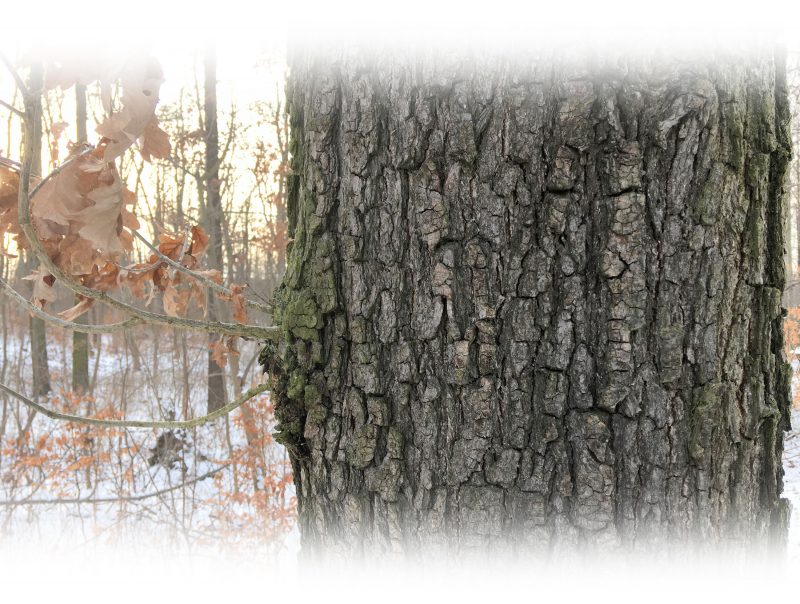
KaiKemmann / CC BY (https://creativecommons.org/licenses/by/4.0), via Wikimedia Commons
https://commons.wikimedia.org/wiki/File:Bark_of_European_oak_(Quercus_robur)_in_winter,_Woodland_south_of_Schlosspark_Belvedere,_Weimar,_Germany_01.jpg
The commercial exploitation of oak timber and bark increased in Brabant in the early sixteenth century, notably among institutions in Lier and Mechelen possessing extensive lands and concerned with relief of the poor. Investment in forest products was stimulated by a growing population, leading both to expansion of the towns (and thus a greater need for timber for housing) and to increased employment. This provided work for a large number of woodcutters, wood gatherers and transport workers [Figure 13]. The wood was largely sold in Antwerp, while the bark was sold in barrels to tanners, but it is possible that it was also traded to other places and it is very likely that some found its way to dyers.[23]
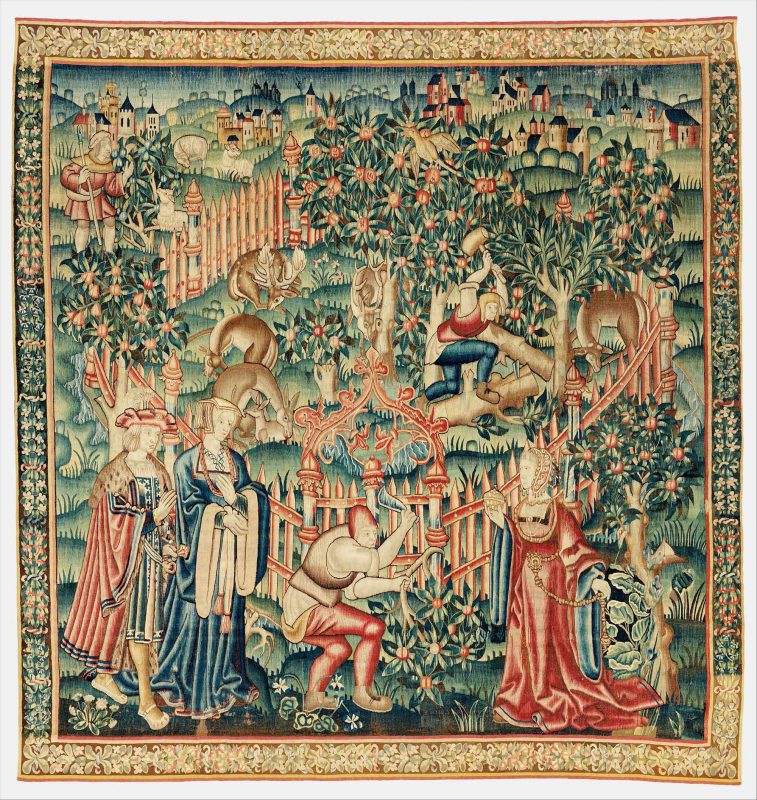
Alder Bark
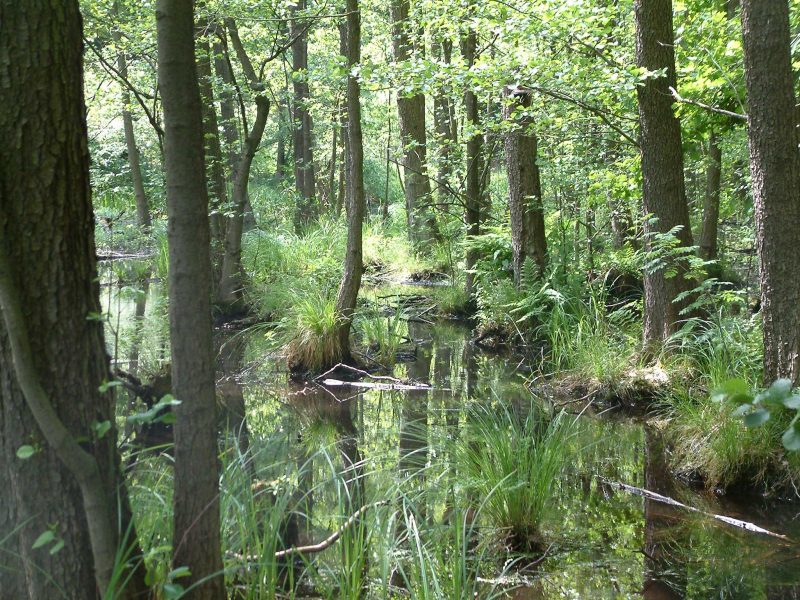
Common alder (Aldus glutinosa (L.) Gaertn.) occurs widely beside streams and on flood plains all over Europe [Figure 14]. A fast-growing tree, alder was coppiced to make straight trunks suitable for poles; it was not suitable for structural building projects, apart from those in wet conditions in which the wood is particularly strong. The seventeenth-century English writer John Evelyn, who was very interested in the cultivation of trees, described the propagation of alder by planting truncheons (large cuttings several feet long) or from seed, a method he said was used in Flanders at that time. This suggests the trees were grown commercially, certainly by the seventeenth century.[24]
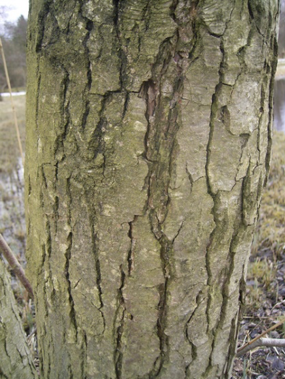
Like oak bark, alder bark is rich in tannins — 16–20% — particularly in the spring when it was usually gathered [Figure 15]. The bark, often known as blec in early Flemish and French regulations, might be sold for dyeing or other purposes: in September 1409, Anthony, Duke of Brabant, bought about 60 barrels of blecken (presumably alder bark) on credit from some Nuremberg merchants, which he immediately sold for cash. Alder was often used with iron swarf (the dust from grinding), the dye being prepared in barrels as alternating layers of bark and swarf, with added water and perhaps vinegar. Dyers using alder bark were commonly referred to as bleckers and the use of iron swarf (slijp) was itself restricted: the fourteenth-century regulations of Ypres permitted its use by bleckers, but it was forbidden to other dyers.[25]
Oak Galls or Gallnuts
Galls form when a female gall wasp punctures the developing buds, leaves or other parts of a tree to deposit eggs. The developing larvae secrete chemicals causing abnormal growth of the plant tissue, resulting in the formation of galls. Many species of gall wasp infect different parts of the oak, depending on the species of both oak and wasp, producing differently shaped galls. The galls most commonly used in Europe were produced on the young twigs of the gall or Aleppo oak (Quercus infectoria Oliv.), found in south-eastern Europe and eastern Mediterranean countries [Figure 16]; however, galls could also be harvested from the pedunculate and sessile oaks. The latter species was the source of the irregularly shaped, so-called acorn gall, which formed between the acorn and its cup and is documented as having been used in Venice. The Mediterranean holm oak (Quercus ilex L.) was the source of the small, yellow Istrian galls. Galls harvested just before the larvae had bored their way out were darker in colour and heavier, with a higher content of tannins; these were sometimes described as ‘blue’ galls. After the insects had escaped, the galls were larger, but lighter in both weight and colour.[26]
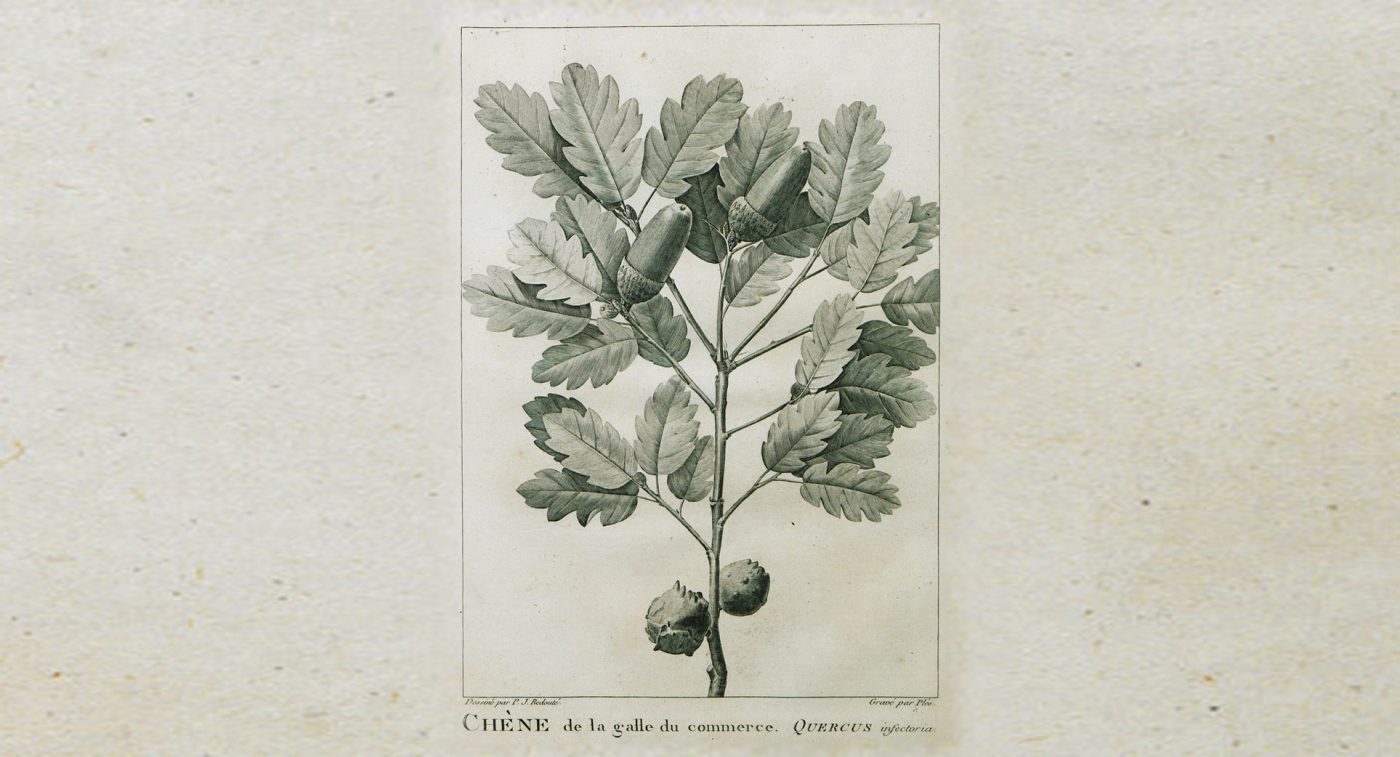
As well as their use in dyeing, galls had been used for centuries for making black ink, with the addition of copperas and a little gum; they could also be used for tanning skins, particularly if light-coloured leathers were desired. They were thus a valuable product, traded to northern Europe principally from countries around the Mediterranean, commonly in Italian ships, at least in the fourteenth and earlier fifteenth centuries. Francesco Balducci Pegolotti listed two varieties, Galla di Romania and Galla di Turchia (probably Aleppo galls), in his handbook and described the best galls as being quite large, heavy and a purplish-green, not yellow, a description close to the ‘blue’ galls mentioned above. The better-quality greenish ones were also smaller than the yellow ones — he drew a diagram showing the relative sizes — although the two were often mixed in the product put on sale.[27]
Pegolotti also listed the ports and trading centres where galls were sold, including Venice, Naples, Palermo, Alexandria, and Constantinople (modern Istanbul — Galla di Turchia are named), and by what system of weights. This sort of information would be needed and recorded by any merchant with an international operation and much later, on 23 October 1394, a record made for the Datini company noted that in Damascus, Turkish galls were sold by the cantar (here, about 179.4 kg) costing 380 diremi per cantar. From the 1380s to the first few years of the fifteenth century, information about purchases and trade in galls is recorded in correspondence between Francesco di Marco Datini and his agents in the network of his company offices. On 28 March 1399, for example, Giovanni Mannelli in Bruges wrote to Datini’s partner in the Majorca office, Cristofano Di Bartolo Carocci, about a delivery of galls, a book, and some iron. Occasionally the galls are described: Galla di Schiavonia in a letter between the company offices in Florence and Pisa; Galla di Romania in one written from the Genoa office to Pisa.[28]
Ships making the long voyage to Flanders from Venice or Genoa usually called in at Southampton on the south coast of England with goods for the English market on their way to the ports serving Bruges. On 27 March 1430, Laurens Markysan took delivery of three bales of gallnuts (noys de Galles) valued at £6, together with brasil (that is, sappanwood), a barrel of green ginger and 22 sacks of cotton, unloaded from a Genoese carrack. Gallnuts arriving in England on the Flanders galleys from Venice in the fourteenth and fifteenth centuries often came from Puglia (southern Italy). However, galls arriving in Flanders or Brabant on the Flanders galleys or by another route were also exported to England directly. Johannes de Carlton paid customs duty on 12 August 1383 on goods including 12 pounds of galls and the same amount of copperas that had arrived in Kingston-upon-Hull (modern Hull) on the Godberade from Camfere, modern Veere, north of Middelburg. Some months later, on 20 April 1384, Rogerus de Moerton received galls, copperas and other goods on the Godewhile of Camfere, and on 11 July the same year he took delivery of a barrel of pepper and more galls, this time on the Godberade.[29]
During the fifteenth century and well into the sixteenth, consignments of galls from the Low Countries to England increasingly came from Antwerp where the English Merchant Adventurers had their base: for example, Thomas Hawkyns, citizen of London, received one bale of galls (gallys) on 26 January 1449 and on 4 August 1458, Arnold van Langfeld received two sacks of galls, as well as six sacks of hops and other items. A century later, on 4 October 1567 John Alden, member of the London Grocers Company, imported 15½ hundredweight of galls valued at £20 13s 4d, and a few weeks later, on 22 October, Thomas Hale, belonging to the same company, took delivery of three hundredweight. In both cases the ships were English, but had come from Antwerp [Figure 17].[30]
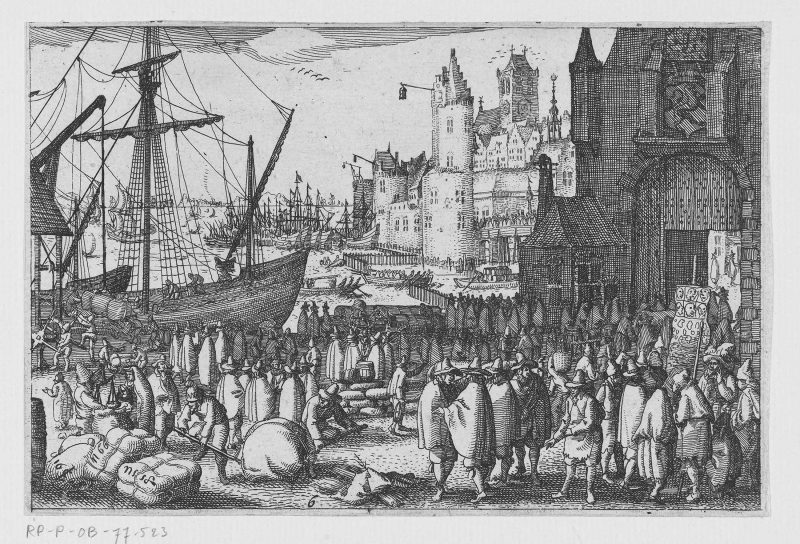
Antwerp merchants such as the Della Faille company imported galls that would then come onto the Antwerp market for sale: in 1578 Jan della Faille with his nephew Jan de Wale, who was based in Venice, obtained 37 sacks of galls together with packs of different cloths. During the 1580s Maarten della Faille, Jan’s son, imported galls from Venice together with silk, currants, rice and mirrors — quite luxurious items. A particularly large consignment of galls obtained in 1584 caused the company considerable problems, however, as it proved very hard to sell. As there was no market for the galls in London, where Maarten had an agent, Thomas Coteels, part of the consignment was sent on to Amsterdam and part to Zeeland. The sale in both those places was very slow indeed; the stock was not sold until 1586 and the initial large purchase was probably largely responsible for the company’s shortage of money that year. Maarten della Faille’s trade with the United Provinces, including Amsterdam and Zeeland, in the difficult years of the 1580s was apparently something of an experiment, although the goods traded did include galls.[31]
Whether or not the galls sent to Amsterdam by Coteels sold well, galls were a regular item of trade there in the 1580s: an incomplete prijscourant listing goods traded on the Amsterdam stock exchange in 1585 — incomplete because the prices were not added — mentions both galnotten van Romania and those from Puglia, which, if they were not brought by sea by merchants like Maarten della Faille, would have come overland. These lists, which were published weekly (probably from 1585), gave prices of goods traded on the Amsterdam stock exchange, the information being collected and published by brokers as an up-to-date list that could be purchased by merchants. It is likely that a precursor of this system, with a published commercial newsletter or list, was produced in Antwerp around 1540, but this did not survive Antwerp’s demise as a commercial centre in the last quarter of the sixteenth century. A later prijscourant of 1626 includes groote gal-noten (priced), but with no indication of the source.[32]
Sumac
The leaves of Sicilian sumac (Rhus coriaria L.), which grows on limestone soils all over southern Europe, are very rich in tannins, about 40% by weight of the dry leaf; even in Sicily the shrub was cultivated. The dried leaves were used both for tanning leather and for dyeing. By the sixteenth century sumac appeared on the market in Antwerp, imported (possibly by way of London) by merchants like the della Faille company. On 10 October 1567, William Coles imported five hundredweight of sumac, which arrived from Antwerp on the Lion of Lee, and John Jackman imported six hundredweight. John Colmer took delivery of four hundredweight of sumac about a fortnight later, on 27 October, which also came from Antwerp. The source of the leaves was not necessarily Italy; Portugal and Spain were other possibilities and were the source of the sumac available in Amsterdam in 1585: both Sumack van Port Aporto (Porto, Portugal) and Sumack van Spangien are listed. This had changed slightly by 1626 when Porto and Malaga are given as the sources of Smack de Port a Port and de Mallega.[33]
Logwood
Logwood (Haematoxylum campechianum L.) is native to the Yucatán Peninsula of Mexico and the surrounding wetlands. The Spanish exploited the trees growing on the eastern side of the Bay of Campeche when they arrived in the region and this has given the wood one of the names by which it came to be commonly known: palo de campeche (Spanish), bois de campêche (French) and campeachy wood (English). The wood is extremely hard and the fact that it was originally traded in the form of logs or blocks has given it its English names of logwood and also, in the late sixteenth and seventeenth centuries, blockwood [Figures 18 and 19]. The names province wood (provinciehout in Dutch), St Martin’s wood (Sint Martens Hout) and bois d’Inde (French) also appear in late-sixteenth- and/or seventeenth-century sources. The principal constituent of the dye is haematoxylin, which is oxidized to haematein when the wood is exposed to the air; the wood also contains tannins that contribute to its properties as a black dye.[34]
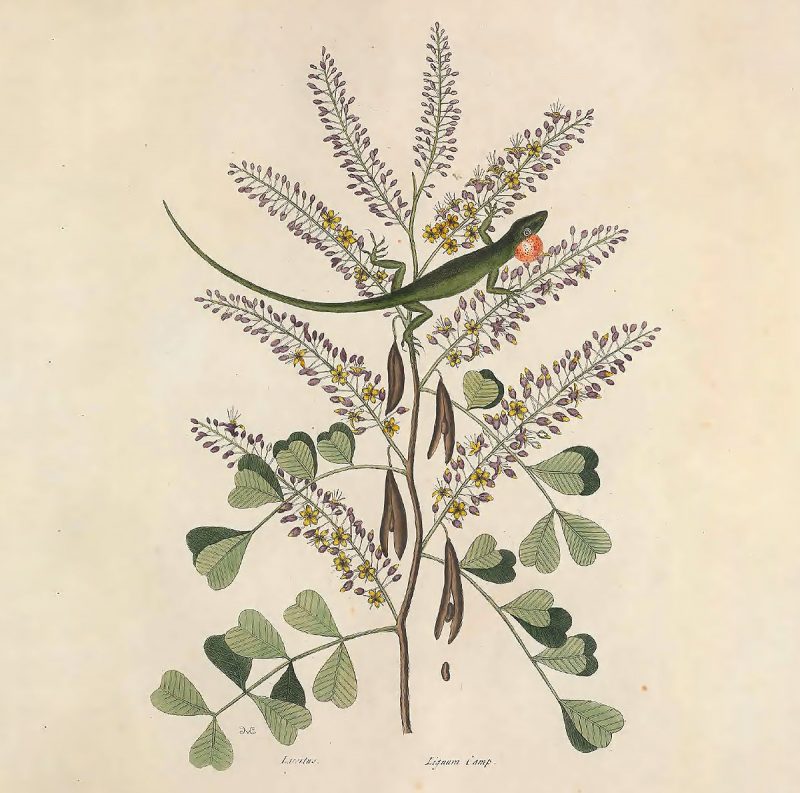
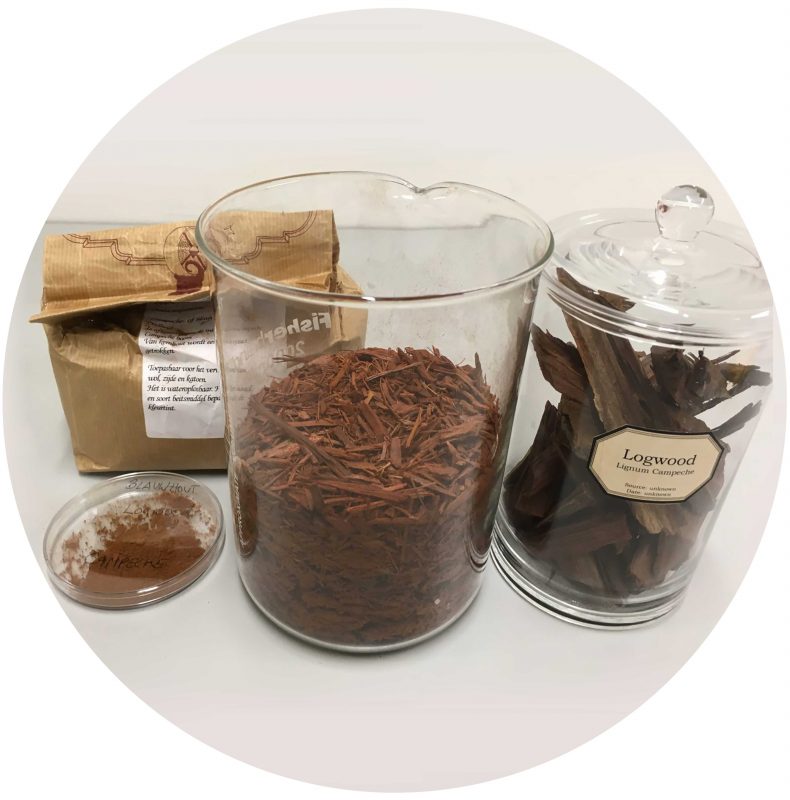
From 1568, the Burgundian–Habsburg Netherlands, then under the rule of the Catholic Habsburg king of Spain, Philip II, suffered periods of considerable political unrest, culminating in the secession of the seven northern provinces to form the United Provinces of the Netherlands in 1581. The remaining ten provinces, including Flanders, Brabant, and the region of Mechelen, remained under Spanish rule. Antwerp declined as a commercial centre after the siege of the city in 1584–1585 by Spanish troops under the command of Alessandro Farnese, Duke of Parma, and the blockade of the Scheldt River, which made sea trade impossible. A large proportion of its population, many of whom were Protestants, emigrated and many, including textile workers, other skilled craftsmen, and merchants, moved north to Amsterdam.[35] It is here that trade in logwood was taking place in the late sixteenth century.
Even before this, however, changes in the desire for and production of lighter, but still high-quality wool textiles, cheaper wools, linens, and other fabrics to satisfy the market at home and abroad had inevitably begun to cause changes in the strict regulations for obtaining black in the dyeing centres of Flanders and Brabant. As mentioned above, obtaining the intense brunette black was a costly process, used only for the most expensive wools and requiring a deeply coloured woad or indigo dyeing as a ground for the subsequent madder dyeing. However, if the iron-containing mordant needed to obtain black with a tannin-containing dye, such as oak galls, was applied over a blue ground that was still dark, but less so than needed for brunette, less mordant would be required.[36] The whole dyeing process was cheaper, less damaging and could be used on the lighter weight and cheaper wools.
From the mid-seventeenth century onwards, logwood was to become one of the most important dyestuffs exported from the New World, largely because of the quality of the black dye that could be obtained from it, described in regulations for dyeing issued by Jean-Baptiste Colbert, Sur-Intendant des Arts et manufactures de France and Controller-General of Finances to Louis XIV and officially decreed by the King in 1669, as giving a black ‘plus noire , plus lustrée, plus douce’ (more black, more lustrous, and softer), when used with galls and copperas than could be obtained by using the galls and copperas alone. However, the immediate appeal of the dyestuff was based on the range of colours that it could give: blues, lavenders, violets, and greys, as well as black. Records for the last decades of the sixteenth century indicate that the Spanish exporters distinguished between palo campeche and palo de tinta, both logwood, in fact, but according to Eufemio Sanz palo de tinta was that traded for dyeing black. In 1566 the Governor of Yucatán, Luis de Céspedes y Oviedo, obtained a licence to fell and extract the wood, renewed in 1571, and demand for logwood is demonstrated by the fact that, in the eight years from 1569 to 1577, Yucatán exported 300,000 quintals (13,800 tonnes; 1 quintal is equivalent to 46 kg) to Spain, from where it was exported to the rest of Europe.[37]
The enthusiasm with which logwood was greeted when it first arrived in Europe was soon tempered by the realisation that its dye was not permanent. This may contribute to the fact that just 10,346 quintals (just under 614 tonnes, combining figures for palo de tinta and palo campeche) were exported to Seville between 1577 and 1593, compared with a total of 114,643 arrobas (28,660.75 quintals, about 1,318.4 tonnes) of cochineal exported over the same period. In England, for example, where logwood had initially been obtained by piracy on Spanish vessels, the official reaction was to prohibit its use: ‘Forasmuch as the colours made with the said Stuff called Logwood, alias Blockwood, is false and deceitful. . . . Logwood shall be forfeited, openly burned, and no cloth or wool shall be dyed therewith’. This 1581 law did not succeed in preventing import of the wood. On 14 August 1588, for example, Thomas Starkey, Alderman of the City of London, imported 54 hundredweight of logwood (about 2.74 tonnes) as well as sarsaparilla (another product from Mexico and other parts of the New World, used for the treatment of syphilis).[38]
The 1581 law was reinforced by another in 1597, but unsuccessful attempts to bring in further measures during the first decades of the seventeenth century show that the wood continued to come into England. Wood that had been impounded was not always burned, partly because no financial benefit accrued to anyone if this was done. In an attempt to solve this difficulty, a royal patent, together with an annual fee, was granted in 1615 to Richard Giles and his deputies to take logwood found in the Port of London and deliver it to the Lord Mayor so that it could be burned; this patent was renewed for the next few years. However, the burning did not always take place. In 1635 John Lanyon, who claimed to have found a method to stain wool and linen ‘in any form and in a variety of colours, such as will endure both washing and wearing,’ petitioned King Charles I to be allowed to take possession of logwood seized by the Searchers, which was yet to be burned, and to test its use.[39]
Use of the dye also continued in spite of the attempts to prevent it. In 1608 a petition was put forward for dyers to be able to make and use a particular (unspecified) mordant, which would enable a successful dyeing with logwood to be carried out. The dyers were interviewed by the Lord Mayor and Recorder of the City of London, whereupon it was found that, although they denied using logwood, they were in fact doing so and that, following a demonstration of the unidentified mordant, the logwood improved the dyeing. The dyers also recorded purchases of more fustic in a month ‘than there is in the Customs’ books in a year’—in other words, disguising the purchase of logwood. The petition was made for ‘the sole making and finding of the fixing stuff to such dyers as dye with logwood … upon good grounds of woad or madder or both’, so using the wood for dyeing black in a similar manner to (and possibly with) the iron-tannate dyes. Eventually it became clear that logwood was too useful to be prohibited; the Government gave up the unequal struggle and the Acts of 1581 and 1597 were finally repealed in 1662. Thirty years later, in 1697–1698, the country that had attempted to ban the use of logwood imported over 1,022 tonnes.[40]
In many cases the wood was imported into London in order to re-export it to other European ports, or this was made a requirement to avoid further punishment, and after the fall of Antwerp, Amsterdam was an increasingly important trading centre and a common destinations for English ships. Logwood was certainly imported into Amsterdam by the 1580s: both Provincehout and Bresille hont Fernabock (brazilwood from Pernambuco or Fernambuco, Brazil) are listed in the 1585 prijscourant (without prices) mentioned above. The 1626 prijscourant is far longer and includes a comprehensive range of dye materials, including campetshout and Sint Martens hout (both logwood) as well as ferneboucq (brazilwood), galls and most of the dyes and mordant materials then in use.[41]
From Amsterdam and other trading centres, logwood was traded to other parts of Europe in ever-increasing amounts. The Sound Toll Registers record tolls levied by the King of Denmark on shipping passing through the Sound, the straits between Denmark and Sweden, and cargoes of logwood are recorded from the first decade of the seventeenth century onwards. Many of the ships’ masters were Dutch, often from the Amsterdam region or from Friesland. For example, on 25 August 1608, Hiøge Symenssen from Flilant (Vlieland, Friesland) passed through the Sound with a cargo including 1,600 pounds of Compesseholdt as well as packs of cloth, sugar, turpentine, lemons, alum, and other goods. Carnillis Nannigssen from Amsterdam was recorded on 26 June 1622, carrying 800 pounds of Compissholt with other goods; and Hyge Isbranttsen, also from Amsterdam, had 1,700 pounds of Provinssenhold in his cargo, recorded on 14 June 1623.[42]
Conclusion
For much of the fourteenth and fifteenth centuries, high-quality wool or woollen fabrics, largely imported from England, were dyed and finished in the textile centres of the Burgundian–Habsburg Netherlands, including Bruges, Mechelen, and other cities. The highest quality wools were dyed with particular care: if black-dyed wool was required, two separate dyeing processes using indigo and madder were needed to obtain the luxurious brunette dye. The easier method, using an iron-containing mordant and a source of tannin, was forbidden on high-quality wool as it was known to damage the textile fibres, although this method was used on other fabrics, including silk. These fine wools were exported across Europe, together with commercially valuable local products such as madder, and were a basis of the prosperity of the Burgundian–Habsburg Netherlands. Meanwhile silks, spices and other luxury items arrived in Bruges, then the focal point of trade in north-western Europe. When Antwerp took over from Bruges as the principal international market of the region, the pattern of trade was broadly maintained, developing considerably during the sixteenth century as the discovery of the Americas brought a new range of goods onto the European market. The growing popularity of lighter weight woollen textiles during the sixteenth century, particularly in the warmer southern European markets, was partly responsible for a change in production: some were still imported from England, but increasingly they were woven locally in Brabant and Flanders in smaller towns and even rural centres. Modifications in dyeing practice to accommodate these new textiles were inevitable and it became permissible to use the iron-tannate dyes on wool previously dyed a reasonably dark blue. The growing political unrest, culminating in the fragmentation of the union of provinces that had formed the Burgundian–Habsburg Netherlands, caused damage to this industry and the impetus for both textile production and international trade moved north to Amsterdam and the northern provinces.
Logwood appeared on the market in the last decades of the sixteenth century, too late to be exploited by the dyers who produced the range of black-dyed cloths for the home and international markets of the Burgundian–Habsburg Netherlands when the country was at its most powerful. However, it arrived at a time of technological experimentation and improvement as dyers, and indeed other craftsmen, came to terms with the behaviour of new products and, in the long term, it was too useful a commodity to be ignored. It could give a black of better quality and greater variability than those given by galls or alder bark, partly because of the range of dye constituents present, and one produced more economically than the brunette of woad, indigo and madder. In general it was used with other dyes and in fact only reached its full potential as a black dye two centuries later, with the development of a new chromium-containing mordant. However, by use of logwood, galls, and alder or oak bark, with judicious additions of other dyes such as sumac and fustic, and by modifications of the recipes as needed, a range of blacks could be obtained. The ever-growing popularity of black clothing, exemplified in the Burgundian–Habsburg court can be seen in the portraits of men and women through the following centuries.
Bibliography
Asaert, Gustaaf. De Antwerpse scheepvaart in de Xvde eeuw (1394–1480) (Brussels: Verhandelingen van de Koninklijke Academie voor wetenschappen, letteren en schone kunsten van België, Klasse der letteren 35, nr. 72, 1973).
Asaert, Gustaaf. ‘De oudste certificatiën van de stad Antwerpen (1468–1482),’ Bulletin de la Commission royale d’histoire, Académie royale de Belgique, 132 (1966), 261–296.
Asaert, Gustaaf. Documenten voor de geschiedenis van de Antwerpse scheepvaart, voornamelijk de Engelandvaart (1404–1485) (Brussels: Koninklijke Academie voor wetenschappen, letteren en schone kunsten van België, 1985).
Asaert, Gustaaf. ‘Handel in kleurstoffen op de Antwerpse markt tijdens de XVe eeuw’, Bijdragen en Mededelingen betreffende de Geschiedenis der Nederlanden, 88 (1973), 377–402.
Boorsma, Peter, and Joost van Genabeek. Commercial and Financial Serial Publications of the Netherlands Economic History Archives; Commodity Price Currents, Foreign Exchange Rate Currents, Stock Exchange Rate Currents and Auction Lists, 1580–1870 (Amsterdam: Netherlands Economic History Archives, 1991).
Brown, Rawdon, ed. Calendar of State Papers Relating To English Affairs in the Archives of Venice, Volume 1, 1202–1509 (London: Her Majesty’s Stationery Office, 1864), available online at https://www.british-history.ac.uk/cal-state-papers/venice/vol1 , accessed 31 December 2019.
Bruce, John, ed. Calendar of State Papers Domestic: Charles I, 1635-6 (London: Her Majesty’s Stationery Office, 1866), available online at https://www.british-history.ac.uk/cal-state-papers/domestic/chas1/1635-6 , accessed 11 December 2019.
Brulez, Wilfrid. ‘Bruges and Antwerp in the 15th and 16th Centuries: an Antithesis?’ Acta Historiae Neerlandicae/Studies on the History of the Netherlands, 6 (1973), 1–26.
Brulez, Wilfrid. De firma della Faille en de internationale handel van Vlaamse firma’s in de 16e eeuw (Brussels: Paleis der Academiën, Verhandelingen van de Koninklijke Vlaamse Academie voor wetenschappen, letteren en schone kunsten van België, Klasse der letteren, nr. 35, 1959).
Bruscoli, Francesco Guidi. ‘Trade with Northern Europe,’ in Francesco di Marco Datini, the Man, the Merchant, ed. Giampiero Nigro (Florence: Firenze University Press Fondazione Istituto Internazionale di Storia Economica, 2010), 395–417.
Cardon, Dominique. Natural Dyes: Sources, Tradition, Technology and Science (London: Archetype, 2007).
Collection des keuren ou statuts de tous les métiers de Bruges, publiée par le Comité-Directeur de la Société d’Emulation de Bruges, avec des notes philologiques de M. J. F. Willems (Ghent: C. Annoot-Braeckman, 1842).
Cours vander commenschappen soo die hier in Amsterdam geldende sijn (Amsterdam: 1585), NEHA, Nederlandsch Economisch-Historisch Archief, Amsterdam, accessible at https://vbh-bedrijfshistorie.nl/prijscourant-amsterdam-1585/ (Vereniging Bedrijf en Historie), accessed 15 January 2020.
Cours van Negotie t’Amsterdam den 28 december, Anno 1626, NEHA, Nederlandsch Economisch-Historisch Archief, Amsterdam AMS.1.01 Fol B.
Dietz, Brian, ed. The Port and Trade of Early Elizabethan London: Documents (London: London Record Society, 1972).
Doehard, Renée. Études anversoises: documents sur le commerce international à Anvers 1488–1514, 3 vols (Paris: S.E.V.P.E.N., 1963).
Doursther, Horace. Dictionnaire universel des poids et mesures, anciens et modernes (Brussels: M. Hayez, 1840).
Drost, Mappie A., ed. Documents pour servir à l’histoire du commerce des Pays-Bas avec la France jusqu’à 1585. Tome II: Actes notariés de Bordeaux 1470–1520 (The Hague, Instituut voor Nederlandse Geschiedenis, 1989; Rijks Geschiedkundige Publicatiën; Grote Serie 211).
Dumolyn, Jan, and Ward Leloup. ‘The Zwin Estuary: a Medieval Portuary Network,’ in Las sociedades portuarias de la Europa atlántica en la edad media, ed. Jesús Ángel Solórzano Telechea, Beatriz Arízaga Bolumburu and Michel Bochaca (Logroño: Instituto de Estudios Riojanos, 2016), 197–212.
Espinas, Georges, and Henri Pirenne. Recueil de documents relatifs à l’histoire de l’industrie drapière en Flandre, Part 1, Des origines à l’époque bourguignonne, vol. 3 La Gorgue – Ypres (Brussels: Libraire Kiessling et Cie, 1920).
Evelyn, John. Silva, or, a Discourse of Forest-Trees, and the Propagation of Timber in His Majesty’s Dominions; as it was Delivered in the Royal Society, on October XV. MDCLXII [1662] … , with notes by A. Hunter, 5th edition, 2 vols (London: Henry Colburn, 1825).
Frankopan, Peter. The Silk Roads: A New History of the World (London: Bloomsbury, 2015), 136–263.
Gelder, Maartje van. Trading Places: The Netherlandish Merchants in Early Modern Venice (Leiden: Brill, 2009).
Gelderblom, Oscar C. ‘From Antwerp to Amsterdam: The Contribution of Merchants from the Southern Netherlands to the Commercial Expansion of Amsterdam (c. 1540–1609),’ Review (Fernand Braudel Center), 26 (2003), 247–282.
Green, Mary Anne Everett, ed. Calendar of State Papers Domestic: Elizabeth, Addenda 1580–1625 (London: Her Majesty’s Stationery Office, 1872), available online at https://www.british-history.ac.uk/cal-state-papers/domestic/edw-eliz/addenda/1580-1625 , accessed 11 December 2019.
Hofenk de Graaff, Judith H. The Colourful Past: Origins, Chemistry and Identification of Natural Dyestuffs, with contributions from W.G.Th. Roelofs and M.R. van Bommel (London: Archetype Publications/ Riggisberg: Abegg-Stiftung, 2004).
Instruction générale pour la teinture des laines et manufactures de laine de toutes couleurs (Paris: François Muguet, 1671).
Kirby, Jo. ‘Painting in a Wider World: Developments in the Trade in Painters’ Materials,’ in Trading Paintings and Painters’ Materials 1550–1800; CATS Proceedings, IV, 2018, edited byed. Anne Haack Christensen and Angela Jager (London: Archetype Publications in association with CATS [Centre for Art Technological Studies and Conservation, Copenhagen], 2019), 1–14.
Massa, Paola. L’arte genovese della seta nella normativa del XV e del XVI secolo (Genoa: Società Ligure del Storia Patria, 1970) [Atti della Società Ligure del Storia Patria, N.S. 10 (84), fasc. 1].
Melis, Federigo. Aspetti della vita economica medievale (Studi nell’ archivio Datini di Prato) (Siena: Monte dei Paschi di Siena, 1962; distributed by Leo S. Olschki, Florence).
Munro, John H. ‘Bruges and the Abortive Staple in English Cloth: An Incident in the Shift of Commerce from Bruges to Antwerp in the Late Fifteenth Century,’ Revue belge de philologie et d’histoire, 44 (1966), 1137–1159.
Munro, John H. ‘The Low Countries’ Export Trade in Textiles with the Mediterranean Basin, 1200–1600: A Cost-Benefit Analysis of Comparative Advantages in Overland and Maritime Trade Routes’, Working Papers munro-99-01, University of Toronto, Department of Economics. Handle: RePEc:tor:tecipa:munro-99-01; https://EconPapers.repec.org/RePEc:tor:tecipa:munro-99-01 , accessed 20th January 2020.
Munro, John H. ‘Spanish Merino Wools and the nouvelles draperies: an Industrial Transformation in the Late Medieval Low Countries,’ Economic History Review, 58 (2005), 431–484.
Mus, Octave. ‘De Brugse compagnie Despars op het einde van de 15e eeuw’, Handelingen van het Genootschap voor Geschiedenis te Brugge, 101 (1964), 5–118.
Nie, Willem L.J. de. De ontwikkeling der Noordnederlandsche textielververij van de veertiende tot de achttiende eeuw (Leiden: Boek- en Steendrukkerij Eduard IJdo, 1937).
Origo, Iris. The Merchant of Prato: Francesco di Marco Datini, London, Penguin Books 1963 (1988 reprint).
Overall, W.H., and H.C. Overall, eds. Analytical Index to the Series of Records Known as the Remembrancia 1579–1664 (London, E.J. Francis, 1878), available online at https://www.british-history.ac.uk/no-series/index-remembrancia/1579-1664, accessed 29 November 2019.
Pegolotti, Francesco Balducci. La pratica della mercatura, ed. Allan Evans (Cambridge, MA: Mediaeval Academy of America, 1936).
Poerck, Guy de. La draperie médiévale en Flandre et en Artois, 3 vols, Vol. 1, La technique (Bruges: De Tempel, 1951).
Puttevils, Jeroen. Merchants and Trading in the Sixteenth Century: The Golden Age of Antwerp (Abingdon: Routledge, 2016).
Raithby, John, ed. The Statutes at Large of England and of Great-Britain … in Twenty Volumes; vol. IV: From 1 Mary, AD 1553 to 16 Charles I. AD 1640 (London: George Eyre and Andrew Strahan, 1811).
Sanz, Eufemio Lorenzo. Comèrcio de España con América en la época de Felipe II, 2 vols; vol. 1, Los mercaderes y el tráfico indiano (Valladolid: Servicio de Publicaciones de la Diputación Provincial de Valladolid, 1979), 545–601.
Smit, Homme Jakob, ed. Bronnen tot de geschiedenis van den handel met Engeland, Schotland en Ierland, Part 1, 1150–1485, vol. 1, 1150–1435, The Hague, Martinus Nijhoff, 1928. Also available on line at Huygens ING, https://resources.huygens.knaw.nl/handelengeland , accessed 10 January 2020.
Soens, Tim, Peter Stabel and Tineke Van de Walle. ‘An Urbanised Countryside? A Regional Perspective on Rural Textile Production in the Flemish West-Quarter (1400–1600)’, in Economies, Public Finances and the Impact of Institutional Changes in Interregional Perspective. The Low Countries and Neighboring German Territories (14th–17th centuries), ed. Remi van Schaïk (Turnhout: Brepols, 2015), 35–60.
Sound Toll Registers Online, Database1, passages before 1634, available at https://www.soundtoll.nl/index.php/en/over-het-project/str-online , accessed 5 January 2020.
Spufford, Peter. Power and Profit: The Merchant in Medieval Europe (London: Thames & Hudson, 2002.
Stauffer, Annemarie. ‘A Purchase List from the Court of Charles the Bold from 1473’, in Inventories of Textiles – Textiles in Inventories; Studies on Late Medieval and Early Modern Material Culture, ed. Thomas Ertl and Barbara Karl (Vienna: Vienna University Press, 2017), 111–126.
Studer, Paul, ed. The Port Books of Southampton, or (Anglo-French) Accounts of Robert Florys, Water-Bailiff and Receiver of Petty-Customs, AD 1427–1430 (Southampton: Cox & Sharland, 1913).
Sutton, Anne F. The Mercery of London: Trade, Goods and People, 1130–1578 (Aldershot: Ashgate, 2005).
Tielhof, Milja van. The ‘Mother of all Trades’; the Baltic Grain Trade in Amsterdam from the late 16th to the early 19th Century (Leiden: Brill, 2002).
TNA E190/8/1. The Port of London. Port: London Official: [Collector of Petty Customs] Overseas inwards. Easter 1588 – Michaelmas 1588. (The National Archives, Kew.)
Van der Wee, Herman. The Growth of the Antwerp Market and the European Economy (Fourteenth to Sixteenth Centuries), 3 vols (The Hague: Martinus Nijhoff, 1963).
Van der Wee, Herman. ‘Structural Changes and Specialization in Southern Netherlands Industry, 1100–1600’, in The Low Countries in the Early Modern World, ed. Herman van der Wee (Aldershot: Variorum, 1993), 201–222.
Van der Wee, Herman. ‘Trade in the Southern Netherlands, 1493–1587’, in The Low Countries in the Early Modern World, ed. Herman van der Wee (Aldershot: Variorum, 1993), 87–114.
Van Houtte, Jan A. ‘The Rise and Decline of the Market of Bruges,’ Economic History Review, 19 (1966), 29–47.
Wilson, Helen, Chris Carr and Marei Hacke. ‘Production and Validation of Model Iron-Tannate Dyed Textiles for use as Historic Textile Substitutes in Stabilisation Treatment Studies,’ Chemistry Central Journal 6 (2012) no. 44, available at https://bmcchem.biomedcentral.com/articles/10.1186/1752-153X-6-44 (open access).
Zwick, Daniel. ‘Bayonese Cogs, Genoese Carracks, English Dromons and Iberian Carvels: Tracing Technology Transfer in Medieval Atlantic Shipbuilding,’ Itsas Memoria: Revista de Estudios Marítimos del País Vasco, 8 (2016), 647–680.
[12 Pegolotti, La pratica, 239; Zwick, “Bayonese Cogs.”
[1] Brulez, “Bruges and Antwerp”; Dumolyn and Leloup, “The Zwin Estuary”; Munro, “Bruges and the Abortive Staple”; Puttevils, Merchants, 3–17; Van der Wee, “Trade”; Van Houtte, “The Rise and Decline.”
[2] Frankopan, The Silk Roads, 136–263.
[3] Cardon, Natural Dyes, 20–30, 39–42, 108–121, 169–177, 191–195, 274–289, 354–377, 410–418, 422–427, 610–619, and 635–666.
[4] Kirby, “Painting,” 1–4, Sanz, Comèrcio, 1: 545–601.
[5] Wilson, Carr and Hacke, “Production and Validation.”
[6] Stauffer, “A Purchase List.”
[7] Massa, L’arte genovese, 119–120 and 211. The full list is oak galls, copperas, gum arabic, filings of rusty iron, madder, vinegar and soap: “galla, vitriola, goma, limagia rausìa, roza et acceto e sapone” (211). Nothing else could be added. If used, madder could have contributed a warmer shade to the black achieved.
[8] On prohibition of the use of iron-tannate dyes, see de Poerck, La draperie, 189–190; Collection des keuren, 116–118; on brunette dyeing, see Collection des keuren, 87 and 90; on lighter weight textiles and changes in their production, see Collection des keuren, 90; Munro, “Spanish Merino Wools”; Soens, Stabel and Van de Walle, “An Urbanised Countryside”; Van der Wee, “Structural Changes.”
[9] Spufford, Power and Profit, 12–34 (this book gives a useful background to trade in Europe, primarily in the fourteenth century); Munro, “The Low Countries’ Export Trade.”
[10] Pegolotti, La pratica, 239–240.
[11] Melis, Aspetti, 15–16, 24, and 272–276. For information on the archive, see http://datini.archiviodistato.prato.it/ accessed 10 January 2020. See also Origo, The Merchant of Prato; Bruscoli, “Trade.”
[13] Mus, “De Brugse compagnie Despars”; Brulez, De firma della Faille.
[14] Asaert, Documenten.
[15] Asaert, Documenten, no. 32, p. 24; no. 144, p. 85; no. 201, pp. 123–126. A bale, a package of goods wrapped in canvas or other cloth, had no fixed size.
[16] Asaert, De Antwerpse scheepvaart, 333–338; Asaert, Documenten, 14; Sutton, Mercery, 308.
[17] Drost, Documents, no. 78, 12199B FO 3RO-VO, pp. 53–54. A tonneau is equivalent to about 979 kg, although as it was a variable measure it is difficult to be precise: Doursther, Dictionnaire, 540.
[18] Asaert, “De oudste certificatiën”; Doehard, Études anversoises, 1: 78–82; Puttevils, Merchants, 20–26.
[19] Alum was imported from Tolfa in the Papal states through Italian distributors until 1549; thereafter it was sourced from Mazarrón, Spain: Puttevils, Merchants, 69–70. On roads, see van Gelder, Trading Places, 41–46.
[20] Doehard, Études anversoises, 2: no. 1352, p. 194; 2: no. 1751, p. 253; 3: no 2366, p. 36.
[21] Asaert, “Handel in kleurstoffen.”
[22] Doehard, Études anversoises, 2: no. 1101, p. 162.
[23] Van der Wee, Growth of the Antwerp Market, I: 29, 100, 102, and 242–244; II: 116–18.
[24] Evelyn, Silva, 1: 240–244.
[25] On the purchase of blecken by the Duke of Brabant, see Van der Wee, Growth of the Antwerp Market, I: 25, note 123; on preparation of the dye, see Cardon, Natural Dyes, 423 and 425–427; de Nie, De ontwikkeling, 196–9; Hofenk de Graaff, The Colourful Past, 294–295; on the Ypres legislation, see Espinas and Pirenne, Recueil de documents, no. 42, 623–624.
[26] Cardon, Natural Dyes, 410–412 and 414–418.
[27] Pegolotti, La pratica, 295 and 371.
[28] Melis, Aspetti, doc. 209, p. 384. The cantar varied considerably in size across Italy, Turkey and the Mediterranean region: Doursther, Dictionnaire, 86–88). For the letters, see http://datini.archiviodistato.prato.it/ Carteggio specializzato / Ricordanze / Busta 1167, codice 9302321; Carteggio specializzato / Estratti-Conto / Busta 444, inserto 7, codice 400558, 25/09/1383; Carteggio specializzato / Estratti-Conto / Busta 505, inserto 13, codice 101127, 19/01/1384.
[29] On ships calling at Southampton, see Studer, Port Books of Southampton, 112; on galls from Puglia, see Brown, Calendar of State Papers ... Venice, cxxxv–cxxxix; on galls imported into Kingston-upon-Hull, see Smit, Bronnen, no. 603, pp. 354, 361, 364.
[30] Asaert, Documenten, no. 164, p. 99; no. 199, p. 122; Dietz, The Port and Trade, no. 18, p. 3; no. 45, p. 7 (the London Port Book for 1567/8).
[31] Brulez, De firma della Faille, 55, 98–102, 124–125, and 133. One hundred sacks of galls, said to be for a friend, arrived from Venice on the Saint John: 124.
[32] On the earlier Antwerp current price lists, see van Tielhof, ‘Mother of all Trades’, 149–151; for the Amsterdam price lists, see Cours vander commenschappen ... 1585; Cours van Negotie t’Amsterdam ... 1626; Boorsma and van Genabeek, 5.
[33] Brulez, De firma della Faille, 103; in this case sumac was imported in 1586 by Filippo Corsini, an Italian living in London who was a partner in a della Faille project to trade goods with Naples and with Spain; for London, see Dietz, Port and Trade, 3 and 8; for Amsterdam, see Cours vander commenschappen ... 1585; Cours van Negotie t’Amsterdam ... 1626; Boorsma and van Genabeek, 5.
[34] Cardon, Natural Dyes, 264–268.
[35] Gelderblom, “From Antwerp to Amsterdam.”
[36] Cardon, Natural Dyes, 416–417.
[37] For the description of logwood black, see Instruction générale, 28–29; on varieties of wood exported, see Sanz, Comèrcio, 1: 600–601.
[38] For volume of logwood exports, see Sanz, Comèrcio, 1: 550 and 598–601; for English laws banning the use of logwood, see Raithby, Statutes at Large, 398 and 528; for import of logwood by Starkey, see TNA E190/8/1. The Port of London ... Overseas inwards. Easter 1588 – Michaelmas 1588, f. 66r.
[39] For the patent for seizing logwood, see Overall and Overall, Analytical Index, 118–123 (IV.6, 22 November, 1615; IV.45, 30 November, 1616; IV.86, 23 September, 1617; IV.94, 22 December, 1617); for Lanyon’s petition, see Bruce, Calendar of State Papers ... Charles I, 1635–6, 73.
[40] Green, Calendar of State Papers Domestic: Elizabeth, Addenda 1580–1625, 510–511. The dyewood fustic was used for yellows and browns. On the 1697–8 imports, see Kirby, “Painting,” 8.
[41] Cours vander commenschappen ... 1585; Cours van Negotie t’Amsterdam ... 1626; Boorsma and van Genabeek, 5.
[42] Sound Toll Registers Online, 1, passages before 1634, records 4340023, 4220782, 4144303.